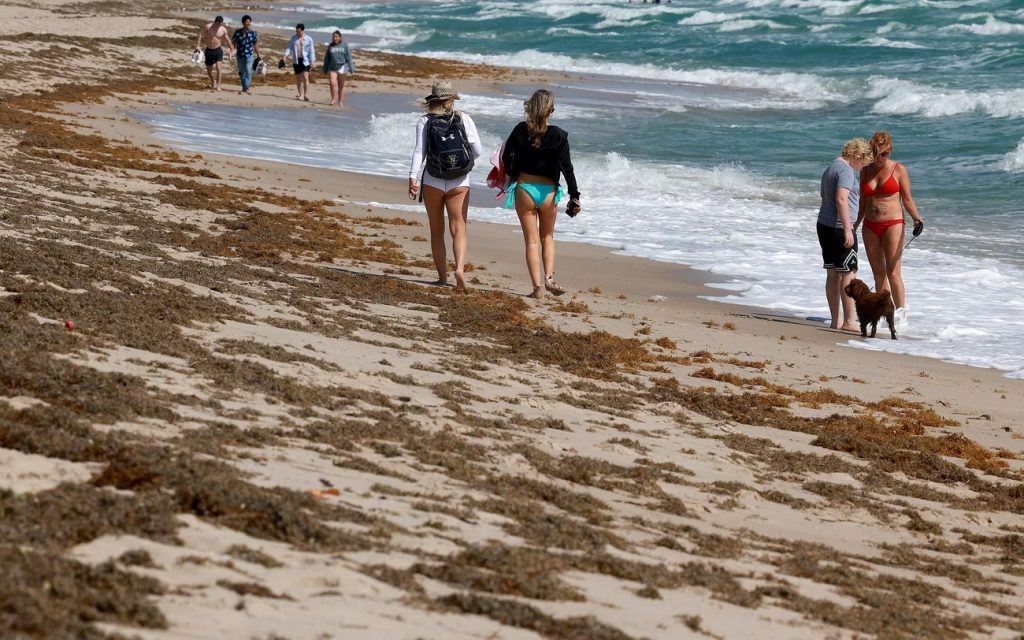Will there be seaweed, red tide on Florida beaches for Spring Break 2024?

A near-record amount of seaweed is sprouting in the Atlantic Ocean on a westward track that could bring the prickly pelagic flora to Florida later this spring.
Thankfully, no red tide has been detected at any Florida beaches. Red tide is an algae that produces a toxin that, when inhaled, can cause respiratory symptoms in people.
But University of South Florida scientists said in January that nearly 5 million metric tons of sargassum was measured in December, far above the roughly 1 million metric tons recorded at the same time the previous year.
The amount has since multiplied to about 9 million metric as tons as of last month, representing the second-highest total amount of sargassum on record for February.
While the mat of sargassum, which stretches from the Lesser Antilles to near the African coast, is moving west into the Caribbean Sea, it’s unlikely to reach Florida this month.
The March sargassum outlook from USF’s Optical Oceanography Lab says the southeast coast of Florida, including the Florida Keys, will remain largely free of sargassum until at least late April or May. That will keep the beaches clear for the annual college student pilgrimages to sites from Miami Beach to Daytona Beach to Panama City Beach.
Very little sargassum was growing in the Gulf of Mexico and Caribbean Sea early this year, but it was flourishing in the western Atlantic and represented a new record amount of growth in the eastern Atlantic. The report notes that heavy cloud cover during the second half of February may have obstructed satellite capabilities meaning the value in the “eastern Atlantic may be subject to large uncertainties.”
Sargassum is a lifeline for fish nurseries, hungry migratory birds and sea turtle hatchlings seeking shelter in its buoyant saltwater blooms. But in mass quantities, it chokes life from canals, clogs boat propellers and is a killjoy at the beach, piling up several feet deep like a rotting bog emitting hydrogen sulfide as it decomposes.
It’s generally safe to swim in, but can turn the water an uninviting brown and be uncomfortable when it scratches against your skin.
“I’ve been in it to where it’s really hard to move through,” said surfer Cameron Koehler, an employee at Nomad Surf Shop near Briny Breezes in a January interview. “It can be super itchy, like a plastic feel with a bunch of little thorns.”
It’s too early to know how much seaweed will reach Florida’s beaches, if any, but it has shown up in varying degrees and depths during every major growth year, hitching a ride on the loop current to assail the Keys and areas north from Miami to Jacksonville.
Is climate change to blame for all the sargassum seaweed?
A 2020 report that included research by the National Oceanic and Atmospheric Administration linked the proliferation of sargassum in the tropical Atlantic Ocean to a 2009-2010 change to the negative phase of the North Atlantic Oscillation, or NAO.
The negative phase of the jet stream meddling NAO means a strong shift in winds to the west and south. Those winds flushed enough sargassum out of the Sargasso Sea, which stretches from around Bermuda east to the central Atlantic, to establish a colony in the tropical Atlantic Ocean.
There, the sargassum got more sunshine and a high dose of nutrients from upwelling ocean waters, according to the report published in the journal Progress in Oceanography in March 2020.
NOAA scientists said earlier this year that it’s unknown if climate change led to the severe NAO shift in 2009-2010 but that humans help feed the sargassum bloom with higher nutrient discharges from rivers, such as the Amazon, where deforestation is occurring.
Higher rainfall amounts caused by a warmer climate can also mean more runoff from other rivers that exacerbate the bloom, including the Mississippi River and the Orinoco River in South America.
Will there be red tide in Florida for spring break?
No red tide has been detected as of March 1 at any Florida beaches, according to the Florida Fish and Wildlife Conservation Commission’s weekly report.
Red tide is an algae formally known as the single-cell Karenia brevis. It produces a toxin as a defense mechanism that, when inhaled, can cause respiratory symptoms in people, such as coughing, wheezing and sore throats. In marine life, it’s a killer that affects the nervous system and can cause paralysis.
In February 2023, a minuscule amount of red tide was detected near the Juno Beach Pier in mid-February, but subsequent tests showed Palm Beach County beaches clear of red tide.
What about sea life? Spring breakers should be wary of some critters
Portuguese men-of-war look like harmless purple balloons on the beach, but their lengthy tentacles can cause extreme pain if touched.
While serious reactions to a man-of-war sting are rare, if the tentacles get wrapped around a person, they can stick to the skin, causing lines of red welts that can last for several days. Tentacles can still cause stings after being broken up in rough surf or even after the man-of-war washes ashore and dies.
Although often confused with a jellyfish, the man-of-war is actually a siphonophore, according to the National Oceanic and Atmospheric Administration. A siphonophore is composed of different organisms with various functions all working together as one.